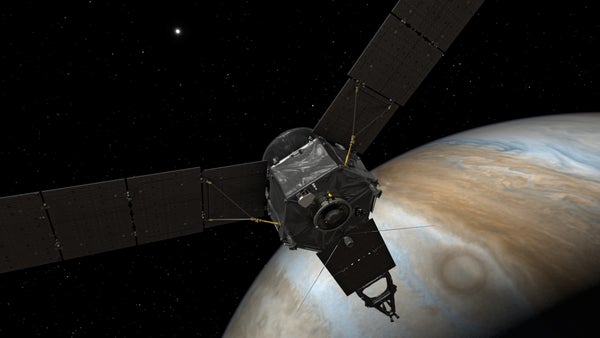PASADENA, Calif.—Apart from the sun, no celestial body has influenced life on Earth as much as Jupiter. The shape of the solar system is largely its doing. In our solar system’s youth the gas giant’s footloose migration toward and away from our star flicked aside lesser worlds—a pruning that, as brutal as it was, opened up space for our planet. Jupiter may have seeded early Earth with icy materials, and later shielded us from devastating comet collisions, yet Jupiter itself is largely a cipher. Did it build up slowly like the other planets or was it born in a single gravitational whoosh like a tiny star? If has moved around, where did it originally form?
We may soon find out. The Juno spacecraft, streaking toward its rendezvous with Jupiter, crossed the orbit of the outermost of that planet’s large satellites, Callisto, yesterday at 11 A.M. Pacific time. If a do-or-die rocket burn goes as planned on Monday evening, Juno will become the second spacecraft ever to orbit Jupiter, after the Galileo mission that arrived in 1995. Galileo toured the entire Jovian system, glimpsing many of its satellites up close before its mission ended in 2003. Juno will instead focus on the planet itself, systematically surveying it across up to 37 orbits that take it within 5,000 kilometers of the cloud tops. And, unlike Galileo, which used a nuclear power source, Juno’s electricity comes from the sun—a first for a spacecraft operating in the outer solar system.
Juno is designed to map the gravitational field of the planet, thereby revealing its internal layering—and, in particular, whether it has rocky core, which would be evidence for a slow buildup. Measurements of the planet’s composition could help identify its birthplace. The little probe that Galileo dropped into the atmosphere in 1995 found that Jupiter is anomalously enriched in certain heavy elements such as nitrogen and argon, as if it formed farther from the sun where those gases were abundant. But one heavy element—oxygen, bound up in water vapor within Jupiter’s roiling atmosphere—was found to be lacking. Either the probe unluckily dropped into a dry spot in Jupiter’s clouds or theorists do not understand how the planet arrived at its boon of heavy elements. Telescope observations from Earth have done little to solve these mysteries because the planet’s clouds get in the way. Up close, Juno’s microwave radiometer will probe the water concentrations to a depth of about 500 kilometers, well under the clouds.
Then there is Jupiter’s magnetic field, which at its source is some 20,000 times stronger than Earth’s (although it weakens with distance and, at the cloud tops, is only about 20 times more intense than Earth’s surface field). The mighty field overpowers the sun’s over a vast distance—in fact, Juno entered its domain on June 25, when the spacecraft was still eight million kilometers away. But what generates it? Presumably it has something to do with the fact that Jupiter is not really a “gas” giant but rather a metal giant: the interior pressure turns hydrogen into a metallic liquid. Juno’s magnetometer will measure the field and thereby the depth to its source. By the end of the mission, we may well know more about Jupiter’s magnetic field than Earth’s.
Monday’s rocket burn is just the first step in a months-long process of entering orbit. The main engine is scheduled to fire at 8:18 P.M. PT for 35 minutes to reduce Juno’s speed of about 58 kilometers per second by roughly 1 percent—just enough to fall into the planet’s gravitational embrace. It will enter an initial 54-day orbit, stretching from 4,500 kilometers above the clouds out to 8.1 million kilometers. During the maneuver, the science instruments will be shut off, just in case they were to interfere, and the main dish will point away from Earth, so the only transmissions we will receive are simple beeps through the backup antenna. The spacecraft will resume gathering data on July 6.
After two such orbits, the engine will fire again on October 19 for 22 minutes, shifting the spacecraft to a 14-day orbit that goes out to 3.3 million kilometers. The main science mission can then begin. Unusually for a planetary orbiter, Juno will pass over Jupiter’s poles. It will swoop down from the north, zoom by the equator at a height of 4,000 to 8,000 kilometers, take data for two hours and head back out from above the south pole. Thrusters will tweak each orbit to longitudinally scan across the planet. The first four orbits will be spaced 90 degrees apart to get a coarse map of the full globe, and subsequent orbits will gradually fill it in.
These come-and-go commando-raid tactics are supposed to keep the spacecraft safely below the inner radiation belt, which wraps around the equator in a toroidal shape. “There’s a doughnut around Jupiter, and we’re flying through the doughnut hole,” explains Bill Kurth of the University of Iowa, who leads the Waves Instrument Team. As further protection, the electronics are shielded behind a centimeter-thick shell of titanium.
For all these precautions, radiation is still the limiting factor of the $1.1-billion mission—and, indeed, the reason that no such mission has been attempted before. “This is the toughest environment in the solar system,” says Matt Bille, a space historian at Booz Allen Hamilton. If the instruments are not completely fried by February 2018, when the main mission is due to end, the team hopes to keep going and gradually lower the point of closest approach. Eventually, the spacecraft, like Galileo in 2003, will burn up in the atmosphere to eliminate the possibility it would ever spread contamination from Earth by crashing into one of the gas giant’s potentially habitable icy moons.
On supporting science journalism
If you're enjoying this article, consider supporting our award-winning journalism by subscribing. By purchasing a subscription you are helping to ensure the future of impactful stories about the discoveries and ideas shaping our world today.
